INDONESIA
Population

Population

Cities in INDONESIA
| Jakarta | Yogyakarta |
Popular destinations INDONESIA
| Bali | Java | Sumatra |
Population
Composition
Anthropologists divide the Indonesian population into three main groups. The Balinese, Madurese, Malays of Sumatra and the Buginese and Massakese of Sulawesi all belong to the deutero-Malay peoples. They generally have a slender physique, copper-colored skin and quite pronounced Mongoloid facial features.
The Dayaks of Kalimantan, the Toradjas and Toalans of Sulawesi, including the Konjos, and the Bataks of Sumatra are referred to as proto-Malay peoples. Their skin is generally lighter and their facial features less Mongolian.
The Austronesian populations of the eastern islands, on the other hand, are darker and have a heavier physique.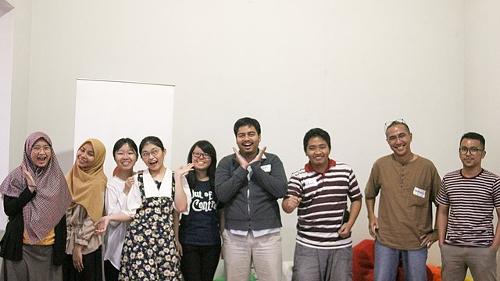 Indonesian people
Indonesian people
Photo: Rachmat04 CC 3.0 Unported no changes made
The archipelago of Indonesia has more than 300 distinct ethnic groups, each with its own identity. There are enormous physical differences between the people of the different parts of the archipelago in terms of pigmentation, hair type, stature and facial features. This ethnographic diversity can be explained by the successive waves of migration from mainland Asia and perhaps even Africa. The various groups arrived in a series of massive waves of migration at intervals of several centuries. It is still unclear how this all happened. Another, more likely explanation is that small groups from Asia slowly entered the Indonesian area and, over thousands of years, mixed with and eventually largely replaced the native Australoid population.
The vast majority of the population belongs to the Malay race. There are clear, mainly cultural differences between Batak, Dayaks and Toradja's on the one hand, and Javanese, the largest group, Sundanese, Madurese, Malays in the narrow sense, Minangkabauers, Acehnese, Buginese and Balians on the other. The Papuans belonging to the Melanesian group live in Irian Jaya and surrounding islands. Peoples showing characteristics of both the Malays and the Melanesians are found on Maluku and on Nusa Tenggara, especially on Timor. There are some small, isolated groups belonging to the European main race, such as the Kubus in Sumatra and the Mentawaiers.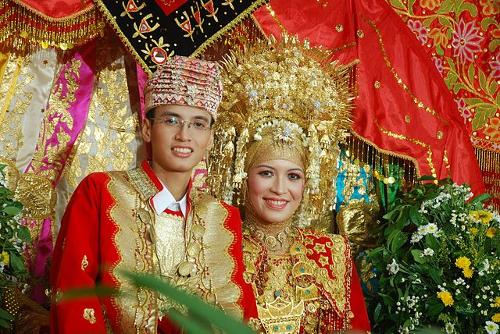 Minangkabau weddingPhoto: Mamasamala CC 3.0 Unported no changes made
Minangkabau weddingPhoto: Mamasamala CC 3.0 Unported no changes made
The Chinese, of whom there are more than 5 million, are by far the most important ethnic subgroup in Indonesian society. The Chinese often live in the port cities and in the larger towns on Java, Sumatra and Kalimantan. They dominate trade and are among the wealthy in Indonesia. The economic success of the Chinese does not make the relationship with the other Indonesians any easier.
Brief description of the population of the large islands.
Sumatra
Most of the population of Sumatra lives in the long chain of undulating hills at the foot of the "Bukit Barisan" and along rivers and lakes in the highlands. This is the home of two large indigenous peoples, the Minangkabauers and the Batakkers. Furthermore, a number of smaller ethnic groups live here, such as the Acehnese, Gayos, Alas, Kubu, Kerinci, Rejang, Mentawei, Enggano and Lampung.
The highlands are thus home to more than three million members of the six main Batak tribes, the Toba, Karo, Pakpak, Simalungun, Angkola and Mandailing. They each have their own dialect, customs and architectural style. The Bataks migrated to Sumatra more than 1,500 years ago from the promontories of the Himalaya in northern Myanmar and Thailand.
Among the northern Bataks there are still animists, among the southern Batakkers Muslims, especially the Mandailing. Many Bataks have been converted to Christianity by German and Dutch missionaries.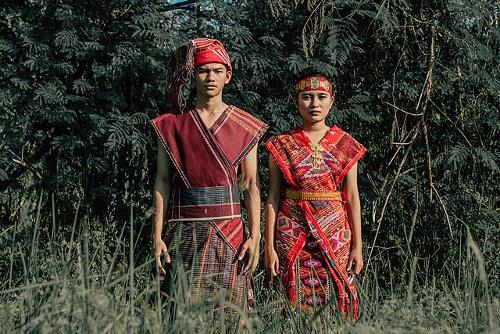 Descendants of the Batak people in traditional dressPhoto: Angeline Claudia CC 4.0 International no changes made
Descendants of the Batak people in traditional dressPhoto: Angeline Claudia CC 4.0 International no changes made
The Minangkabau people mainly live in West Sumatra and are related to the Malays of the east coast of Sumatra. There are currently about seven million Minangkabauers, three million in West Sumatra and four million scattered in major cities throughout Indonesia. The Minangkabauers, in contrast to, for example, the Batakkers, traditionally have a high degree of literacy and great administrative qualities. As a result, they have always played an important role in the political, economic and scientific development of Indonesia. Many well-known Indonesian leaders and writers are therefore from West Sumatra.
Java
The Javanese themselves make up about two thirds of the total population and inhabit the fertile plains of Central and East Java, as well as much of the north coast. In the higher parts of West Java the population consists mainly of Muslim Sundanese, on the island of Madura and the opposite parts of East Java many Madurese live. The Sundanese are indistinguishable in appearance from the Javanese of Central and East Java. The Badui live in the far west and the Tenggerezen in the far east. Many Arabs, Chinese and Europeans have settled in the large port cities along the north coast.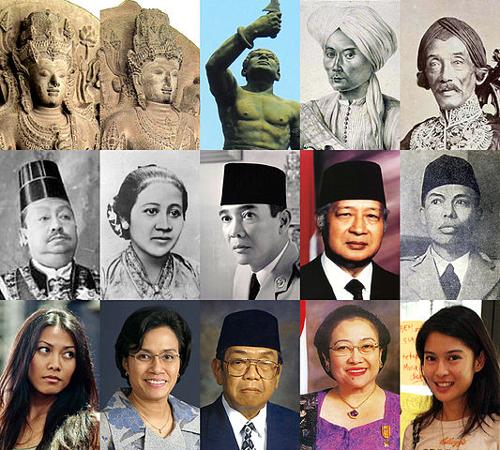 Javanese peoplePhoto: Gunkarta CC 3.0 Unported no changes made
Javanese peoplePhoto: Gunkarta CC 3.0 Unported no changes made
The Sundanese have a culture all their own, with the complex gamelan and angklung music, the popular jaipongan dances and the lively wayang golek performances.
The steep slopes of the active volcanoes Gunung Semeru and Gunung Bromo have been inhabited by the Hindu Tenggezen people for centuries. The Tenggerezen, of which there are an estimated 40,000 left, are being oppressed by the steadily increasing defeat of Madurese and Central Javanese.
The Baduy belong to the so-called Mandala community, which is based on an Old Javanese faith with Hindu-Buddhist traits.
Bali
The largest population group in Bali is formed by the Balinese, who descend from the second wave of migrants.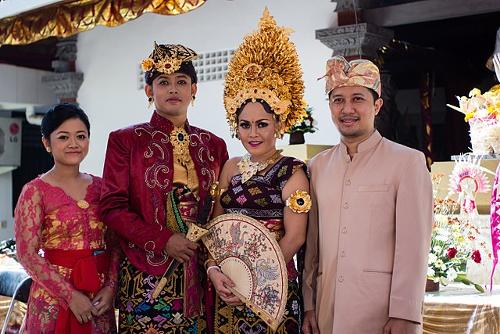 Balinese Hindu wedding in traditional clothingPhoto: Julien Boulin CC 2.0 Generic no changes made
Balinese Hindu wedding in traditional clothingPhoto: Julien Boulin CC 2.0 Generic no changes made
Bali was inhabited relatively early and a Balinese Hindu-Buddhist culture developed with its own high quality character. Bali has the largest Hindu community in the world outside of India. Ninety percent of the Balinese population adheres to Balinese Hinduism.
Until the beginning of the 20th century, the Balinese lived completely isolated from the rest of the world.
Lombok
The population of Lombok consists of Muslim Sasaks, Hindu Balinese, Chinese and Arabs. About 10% of Lombok's population is Hindu and most Lombokkers live in towns and villages on the narrow plains in the mid-west of the island. The vast majority of the population consists of Sasaks, who themselves distinguish between two more or less separate groups, the Waktu-telu who live in the mountains and the Waktu-lima who live in the lowlands.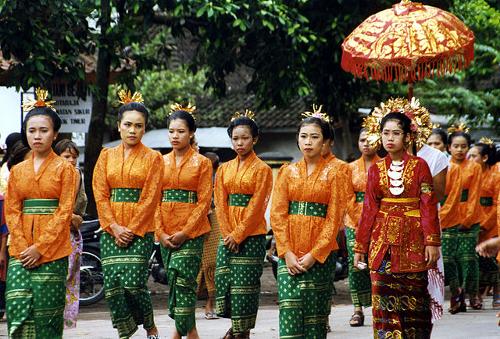 Wedding on Lombok in traditional dressPhoto: Anoldent CC 2.0 Generic no changes made
Wedding on Lombok in traditional dressPhoto: Anoldent CC 2.0 Generic no changes made
The handful of the remaining original inhabitants, the Bodha, live in the isolated southeast of the island.
Nusa Tenggara - The Little Sunda Islands
The inhabitants of the western part of Nusa Tenggara have Mongol characteristics, those of the east tend more towards the Melanesian type.
Nusa Tenggara is one of the poorest and most barren areas in Indonesia. Most of Nusa Tenggara's approximately 10 million residents are farmers or fishermen.
The people of Sumbawa are Muslims. West Sumba has about 350,000 inhabitants, with two separate language groups. The people here still live in traditional stilt houses and the worship of the land and the ancestors is still very much alive. East Sumba is dry and rocky and has about 250,000 inhabitants who all speak the same language.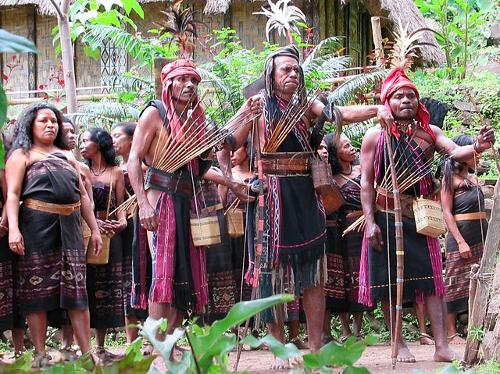 The Abui people of Takpala Traditional Village on Alor Island, East Nusa Tenggara, Indonesia, retain their traditional Melanesian customsPhoto: David Stanley CC 2.0 Generic no changes made
The Abui people of Takpala Traditional Village on Alor Island, East Nusa Tenggara, Indonesia, retain their traditional Melanesian customsPhoto: David Stanley CC 2.0 Generic no changes made
Flores is the largest island in the eastern part of Nusa Tenggara. Today 90% of the approximately 1.4 million inhabitants of Flores are Catholic, but interspersed with many traditional views and customs.
In the east of Nusa Tenggara there are a number of smaller islands, including Solor, Adonara, Lembata, Pantar, Alor, Sawu and Roti. The inhabitants of these islands have been in contact with each other and with the population of the larger islands since time immemorial, and have developed high-quality cultures over the centuries.
Kalimantan
Kalimantan is the name of the Indonesian territory that covers two-thirds of the island of Borneo. The first people from mainland Asia reached Borneo around 3000 BC. Most of the population, mainly Chinese and Malaysians, lives in the coastal areas. East Kalimantan ("Kalimantan Timur" or Kaltim) has only 1.5 million inhabitants in an area the size of England and Scotland combined. The majority are farmers from overpopulated Java.
Central Kalimantan is the home of the Dayaks, the collective name for about 200 different peoples living upstream of the major rivers Kapuas, Barito and Mahakam. The Ngaju are the largest of the groups of Dayaks living in the province. Many of them were converted by the Christian faith, but many others held to the ancient faith of the Dayaks called "kaharingan." Well-known other tribes are: Iban, Kenyah, Tunjung, Kayan, Punan and Benuaq.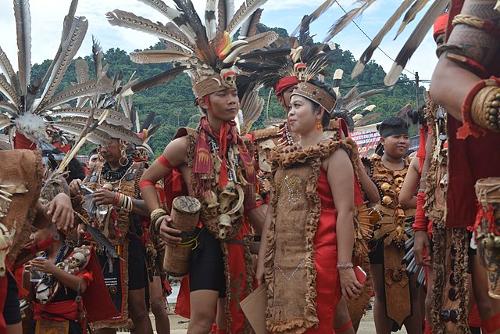 Dayak celebrationPhoto: Antonsurya12 CC 4.0 International no changes made
Dayak celebrationPhoto: Antonsurya12 CC 4.0 International no changes made
The tribesmen of the Penan are the original inhabitants of Borneo, who even lived here before the Dayaks. There are still about 10,000 Penen living in enclaves in the upper catchment area of the Mahakam and Apo Kayan.
West Kalimantan's large Chinese community ("Kalimantan Barat" or Kalbar) is descended from the gold miners who flocked here in the early 1800s. Most of the Chinese continued to live in these areas and married native women. Their descendants now make up one of the largest Chinese communities in Indonesia.
Sulawesi (Celebes)
The island of Sulawesi is home to the highland Toradjas and the seafaring Buginese. The nine million islanders show a great diversity: for example, more than 40 different languages are spoken. Sulawesi's central location in the Indonesian archipelago has contributed a lot to the heterogeneity of the population.
The coastal and lowlands of South Sulawesi are now inhabited by Mongoloid peoples, collectively referred to as "Buginese," traditionally navigators and shipbuilders.
South Sulawesi has about 6 million inhabitants and an average of 125
inhabitants per km2 it is one of the most densely populated areas of Indonesia.
Between the rugged mountain peaks and fertile plateaus of southern Central Sulawesi is the habitat of many isolated living evolves, who share a common ancestry with the seafaring Buginese, Mandarin and Makassarese. The coastal people of Sulawesi call these peoples the "Toraja", the "highland peoples." Their area of residence is called Tanah Toraja or Toradjaland.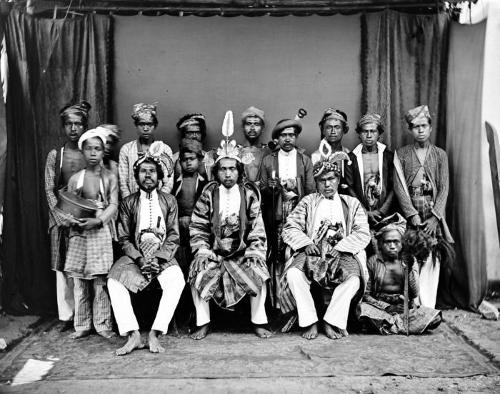 Group portrait with Buton's envoy to SulawesiPhoto: Tropenmuseum CC 3.0 Unported no changes made
Group portrait with Buton's envoy to SulawesiPhoto: Tropenmuseum CC 3.0 Unported no changes made
Traditionally, the Toradjas lived in small walled settlements on the hilltops. In the early 20th century, the Dutch colonial administration ordered the Toradjas to move from their hilltops to the more accessible and controllable valleys and plains. The Toradjas owe their fame to the grand and colorful festivals that are held to ensure that the soul of a deceased person can pass to the realm of the dead or "puya" in a manner consistent with their status on Earth. About 2.3 million people live in North Sulawesi, of which more than 200,000 live in the capital Manado.
The Minahasser peoples are descended from the Mongoloid immigrants who settled here thousands of years ago. Their languages are related to the languages spoken in the Philippines. Later on, large numbers of Chinese and Europeans also settled here and marriages between the groups have created a mixed population.
Maluku
The Moluccas or Maluku is a province with thousands of islands, spread over an area of about 1.5 million km2.
The largest ethnic group in the Moluccas are the Ambonese, who live on Ambon, Saparua, Nusa Laut and Seram.
The pagan Naulu are one of the few remaining peoples of the Moluccas who adhere to their old traditions without any outside religious influence.
Irian Jaya is the western half of New Guinea, the second largest island in the world after Greenland. Irian Jaya is the least populated province of Indonesia. In most areas, fewer than six people per km2 live and there are even areas that are not inhabited.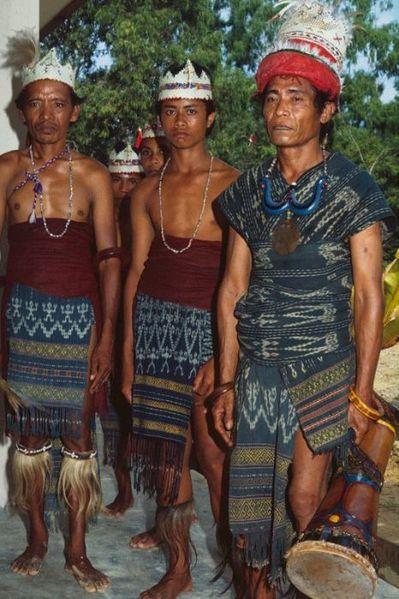 Men in Kota Ambon display Southeastern Moluccan clothing and customsPhoto: Tropenmuseum CC 3.0 Unported no changes made
Men in Kota Ambon display Southeastern Moluccan clothing and customsPhoto: Tropenmuseum CC 3.0 Unported no changes made
The indigenous Papuans are classified as the Blacks, who live in the higher areas and have a very dark house, and a mixture of the Black and Melanesian races who live on the coast and in the lower hilly areas.
The first inhabitants of New Guinea arrived from the west, probably some 60,000 years ago. Small groups settled along the coast and in places not far inland. Probably there was hardly any contact between the different groups on the island, resulting in the incredible number of about 800 languages spoken in New Guinea, about 550 in Papua New Guinea and about 250 in Irian Jaya. A number of languages are spoken by only 2000 people.
People from southern China and Taiwan also arrived on the island, but the majority of Papuans managed to resist assimilation with the newcomers, who only settled on a few nearby islands and coastal areas of the island.
The fertile Baliem Valley is home to the Dani, the most famous inland tribe of Irian Jaya. They lived completely isolated until their discovery in 1938. Now, after more than fifty years of contact with the outside world, the lifestyle has changed somewhat, but the men still only wear the characteristic penis sleeves and the women a skirt of grass.
The land of the Asmat, master woodcarvers from the swamps, is located around the town of Agats. The 70,000-member Asmat tribe is the largest in this region and lives in approximately 100 villages located in an area of 27,000 km2. Most of the Asmats living in the swamps have adopted the Christian faith.
The other peoples in this area are divided into two groups: the peoples on the coast and the peoples in the interior. They speak different dialects and have a different way of life, social structure and ceremonies. The coastal peoples are also divided into two groups: the Bisma and the Simai.
Distribution and demographics
In 2024 Indonesia had 282 million inhabitants. This makes the country the fourth country on earth in terms of population.
The population of Indonesia is very unevenly spread across the archipelago: approx. 67% live in Java (population density: more than 800 people per km2), Madura and Bali, while the three islands together cover only 7% of the total area.
In Jakarta, where 11.2 million people live in 2024, the population density is around 17,000 inhabitants per km2. Other major cities are: Bekasi (3 million) Surabaya (3 million), Depok (2.7 millon) and Bandung (2.5 million).
Efforts of internal emigration ('transmigration') to sparsely populated areas in Sumatra, Kalimantan and Irian Jaya to relieve the pressure of overcrowding in Java have met with limited success. As secondary objectives, regional development and "Indonesianization" were increased (considered by most people outside Java as "Javanization"). Because of the fear of losing their own cultural identity, the programs encountered a lot, sometimes violent, resistance among the population groups in Sumatra, Kalimantan and Irian Jaya. In Irian Jaya in particular, the indigenous population is increasingly likely to become a minority in their own country.
The provinces of Irian Jaya with only 4 inhabitants per km2 and Kalimantan are very sparsely populated. The most densely populated province outside of Java is Lampung.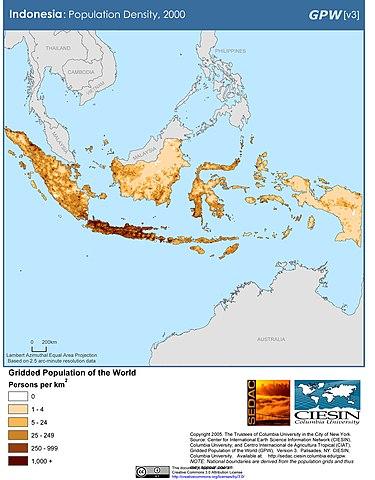 Population density IndonesiaPhoto: Keenan63 CC 4.0 International no changes made
Population density IndonesiaPhoto: Keenan63 CC 4.0 International no changes made
A National Institute for Family Planning has existed since 1968 with the aim of reducing the annual birth surplus. The population has grown less sharply since the 1980s and the birth rate fell from 41.5 per 1000 inhabitants in 1970 to 14.8 in 2024; the death rate fell from 17.5 to 6.8 in the same period. Population growth is estimated at 0.73%, (2024)
23.9% of the population is under 15 years old; the average life expectancy is 76 years for women and 71.3 years for men. Indonesia thus has a very young population.
Slightly more than 40% of the population (2024) lives in rural areas, usually, at least as far as Java is concerned, in closed settlements (dessa, kampong) with a population ranging from many hundreds to less than fifty. The Chinese minority mainly lives in urban centers.
Sources
Dalton, B. / De Indonesië reisgids
Elmar
Darmawie-van Oijen, J. / Indonesië : handboek voor reizigers
Babylon-De Geus
Homburg, E. / Indonesië
Elmar,
Indonesië
Cambium
Lyle, G. / Indonesia
Chelsea House
Martyr, D. / Indonesië
Van Reemst
Mastenbroek, B. / Kijk op Indonesië
Elsevier
Muller, K. / Indonesië : het 13.000 eilandenrijk
Becht
Oosterman, I. / Indonesië
ANWB Media
Schulte Nordholt, N. / Indonesië : mensen, politiek, economie, cultuur
Koninklijk Instituut voor de Tropen / NOVIB
Te gast in Indonesië
Informatie Verre Reizen
Wassing, R. S. / Indonesië : Java, Bali, Lombok, Sumbawa, Komodo, Flores, Sumba, Timor, Sumatra, Zuid- en Oost-Kalimantan, Sulawesi, Singapore
Gottmer
Witjes, B. / Indonesië
Stichting Teleac
CIA - World Factbook
BBC - Country Profiles
Copyright: Team The World of Info